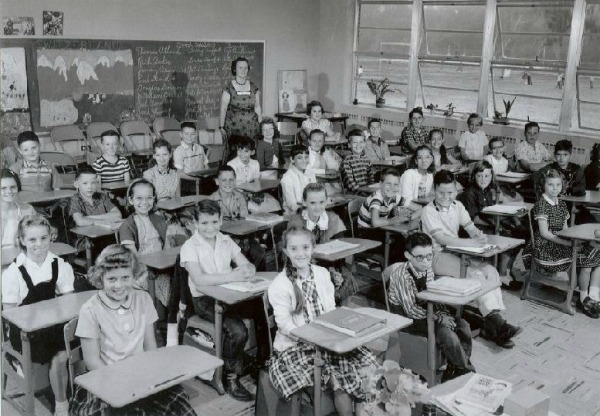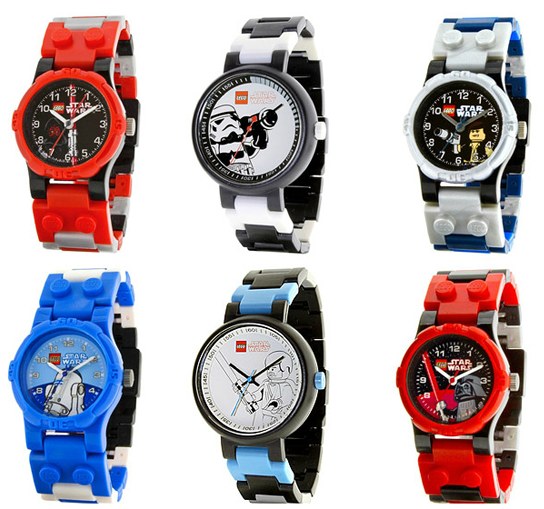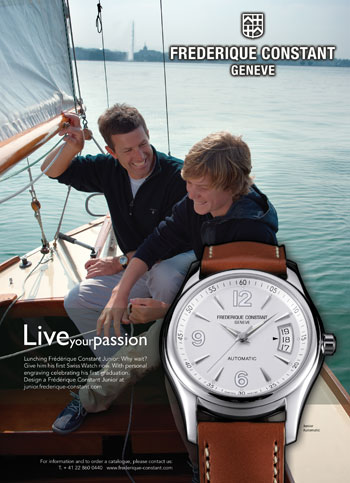
While at Baselworld 2012, I had an interesting idea. It wasn’t totally unique, and I certainly didn’t come up with it originally. I did however stumble upon a solution for a huge problem with the watch industry and a great way to solve it. Something that to my knowledge isn’t really being done with any seriousness today. It has to do with getting more people to wear and want watches, and how to approach a post need-based watch economy.
By “post need-based” I mean that technically speaking, people no longer must wear watches to tell the time. People most certainly still need to know the time, but there are simply other options (perhaps not as convenient) in addition to a wrist watch that will tell you the time. This wasn’t always the case. It used to be that if you wanted to tell the time, you either needed to own a wrist watch, or remain within very close proximity to a clock. And carrying around a grandfather clock in a Radio Flyer wagon behind you wasn’t very practical. Essentially, everyone needed a watch.
People would get their first watch usually as a gift from their parents or relatives – more than likely when they were a kid. It would be something basic and cheap, and something they would inevitably break or grow out of. Then it was time for their next watch. The need for a watch and the importance of owning one was implanted in people at a young age in that world. Thenceforth people were watch wearers for life – most of the time. This was the status quo and all watch makers knew it. While luxury watches were just that, you knew that the entire population was going to need your product.
The 1980s was likely the best thing to happen to this system given the influx of cheap and cool watches that did things no previous watches could do before. The watch was cooler than ever, and people had more options than ever. Then the 1990s came and was just as big a revolution… but in the opposite way. With computers, Walkmans, and mobile phones, people suddenly had other, often more accurate ways to tell the time. A wrist watch started to move from necessary to optional for a large portion of the population. Parents started to get their kids phones, computers, and audio devices earlier and in larger quantities than watches.
One reason for this was cost. A parent wanting to get their child a good Swiss watch was running out of options. Sure there was Swatch – but that is hardly a way to promote a youngster into being a serious watch lover. With the mechanical watch industry reinventing itself as a luxury lifestyle product, many of the items that parents might have bought for their children 10 or 15 years earlier were simply being priced out of the “I would get it for a 12 year old” segment. That is certainly the truth more than ever today. Buying an Omega or Rolex for a youngster in your life is more expensive than getting them a computer, mobile phone, and audio device – combined.

Parents also stopped wearing as many watches for many of the same reasons. Disposable income went more to gadgets and other emerging electronic items that seemed more important or relevant. With casual Friday turning into casual every day, even the status requirements of wearing a fine timepiece for business purposes started to erode – especially in America. Bill Clinton famously campaigned and served in office as the US President wearing a Timex Triathlon – in order to connect better with the common person. His choice of wearing the inexpensive plastic digital sports watch was especially ironic because Clinton himself is and was a major high-end watch collector. Even politics were marginalizing the perceived excess of traditional watches now seen as fodder for the wealthy, and akin to status symbols like clothing from Hermes, Gucci, and Dolce & Gabbana. It just started seeming less and less like something to buy for a kid.
In an economy based on disposable goods, the idea of buying an expensive watch meant to last for many years almost seems foreign. Even with electronics, we are nurtured to upgrade each few years – because let’s face it, we are personally limited by technological obsolescence when it comes to productivity and entertainment. One can make an argument that buying such a non-fungible item for children is an important lesson in caring for one’s property and learning the responsibility of long-term ownership, but I digress.
I mention all this to help explain some of the main reasons why people today are no longer wearing watches quite as much. They didn’t do it as kids, and the need or desire for a watch on their wrist isn’t built into their personality or perpetuated as much by society. Seeing people wear watches on TV is one thing, but what is really missing is personal and community experience.
So the watch industry is in a bit of a bind – especially in places like the United States where wrist watch wearing isn’t as much a part of the culture as it is in Asia and to a large degree, Europe. The bind is that the “interested watch population” is smaller than it should be, media doesn’t really discuss it very well, and young people just aren’t as interested in watches as they could be. I say this with a straight face suggesting that young people really would like watches if they were more familiar with them. This isn’t a plea for mass social manipulation to get people wanting and buying something they otherwise wouldn’t want. This is about exposure and education in regards to something genuinely satisfying (of course I would say that).

The goal is to get young people wearing more watches and to grow up with a bit of watch culture. I suggest a two pronged approach to achieving this. One prong is product related, and the other is marketing related. Let’s talk about marketing first.
Kids aren’t going to buy watches for themselves. They don’t really buy anything for themselves and don’t really have any money. What they do ask for is junk food and toys – that they see on TV. Also the stuff their friends have and show off. How do kids get stuff? Adults. The parents and relatives of children need to buy them watches. These purchases will mostly take the form of gifts. Adults need to buy watches for the kids who are close to them. Why would they do this? Well adults buy things for kids all the time, in the form of gifts, coming-of-age tokens, or simply to show love. What the watch industry needs to do is remind adults that watches are a good option for each of these occasions.
This can be done through a series of marketing campaigns, ideally becoming a trend among many brands. The main message should be a suggestion for parents and adults to choose a watch (perhaps their watch) when considering what gift to get a kid. This is happening a bit right now, but not in a very direct way, and not nearly enough.
A number of watch brands are marketing their products to teenagers and young adults. The problem is that in many instances they are too late and the message is wrong. They are missing the younger more formative years of a person’s life, and campaigns are too focused on asking a teenager to buy a several hundred dollar watch personally, rather than focus on suggesting to an older person to buy a watch that might appeal to a younger person. There is a big difference in these approaches. Such campaigns need to appeal to slightly older people, and frame the message more like “this is a cool watch that a teenager would like.”
The second marketing message is the more complex argument of why an adult should buy a watch as a gift for a kid. You could argue that this has been done before, but I again suggest the mark has been missed much of the time. The most famous example is Patek Philippe’s long standing “…hand down to the next generation…” series of ads. If you are aware of these ads you know what I am talking about. Rather than help encourage older people to buy watches for kids, the ads are actually a value proposition about the long-term emotional and investment properties of a Patek Philippe watch. If anything, the message is “buy a Patek Philippe watch for yourself now. Your child that respects you will see it, and one day when you die or upgrade, they will get it and enjoy knowing you owned and wore it.” Patek Philippe grazes the right concept, but altogether does something different with those particular marketing campaigns.

Frederique Constant, a few years ago, came out with a sub $1,000 range of watches aimed for young boys and girls. They were to be easily engraved with personal messages on the casebacks, and were intended to be ideal gifts for special occasions such as Bar Mitzvahs or graduations. The only problem is that I never really saw any significant ad campaign or efforts around it. It was a good idea with what seemed like an anemic consumer education campaign.
What the entire watch industry needs to do – especially in America – is get the message out there to adults that watches make a nice, traditional, fun, fashionable, and classy gift for the young. The message will (and should) come in a 100 different ways from 100 different sources. If there is success, then new watch wearers will be born.
The second element of this larger idea is related to product. If people have this new found idea to buy watches for kids, then they need to have a good idea of what to buy. It is true that many watches out there right now would be good for kids, but I really think they either needed to be touted as such, or at least packaged as such. Most kid’s watches should be smaller than those for full-grown adults, less expensive, but at the same time items that assert similar values. If you want to buy clothes or toys for a kid, you know where to go. If you want to buy a watch, you are much more on your own. The industry needs to package the concept much better. This means new ranges of watches for kids or repackaging existing products for kids. Don’t make the consumer work too hard to find the right item. Give them easy choices that range from fun to formal, sporty to silly. And make them more mainstream. Brands like Swatch are an obvious choice to start all this.
It is true that some of what I am suggesting is or has been happening on the product side. There are kid’s watches, plenty of them. But do enough of them properly serve as good “gateway watches,” helping a kid step up from watch to watch until they are adults? I am just not sure.
If watch brands agree that getting people to wear watches at an early age is a good idea then it is likely wise to start implementing many of these suggestions. The outcome in 5-20 years is a population that will be more aware of watches, buys more watches, and is more interested in nice watches. It should also have the benefit of raising people that wear watches longer. Perhaps then I will have more to talk about with regular folks.
